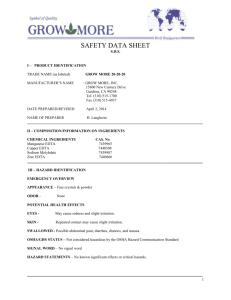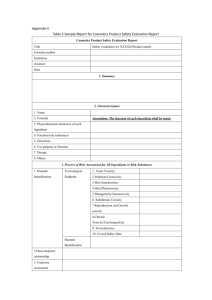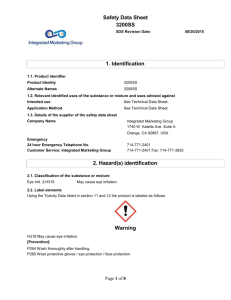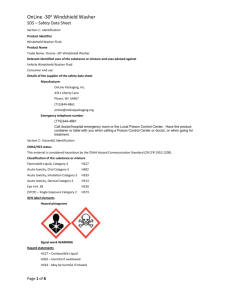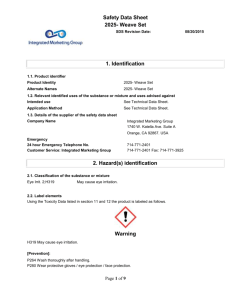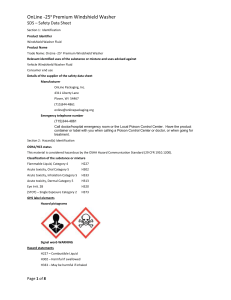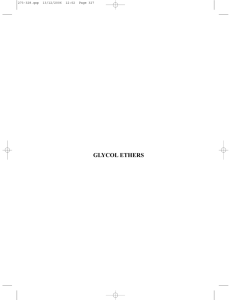+32 Premium Windshield Wash SDS
advertisement
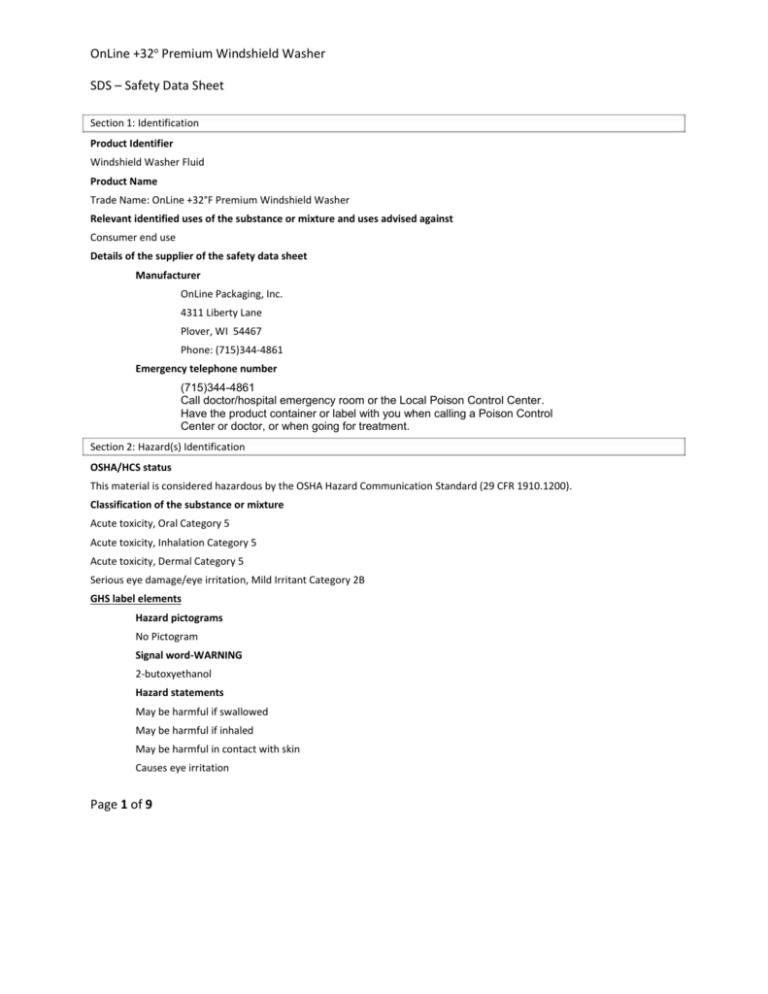
OnLine +32o Premium Windshield Washer SDS – Safety Data Sheet Section 1: Identification Product Identifier Windshield Washer Fluid Product Name Trade Name: OnLine +32°F Premium Windshield Washer Relevant identified uses of the substance or mixture and uses advised against Consumer end use Details of the supplier of the safety data sheet Manufacturer OnLine Packaging, Inc. 4311 Liberty Lane Plover, WI 54467 Phone: (715)344-4861 Emergency telephone number (715)344-4861 Call doctor/hospital emergency room or the Local Poison Control Center. Have the product container or label with you when calling a Poison Control Center or doctor, or when going for treatment. Section 2: Hazard(s) Identification OSHA/HCS status This material is considered hazardous by the OSHA Hazard Communication Standard (29 CFR 1910.1200). Classification of the substance or mixture Acute toxicity, Oral Category 5 Acute toxicity, Inhalation Category 5 Acute toxicity, Dermal Category 5 Serious eye damage/eye irritation, Mild Irritant Category 2B GHS label elements Hazard pictograms No Pictogram Signal word-WARNING 2-butoxyethanol Hazard statements May be harmful if swallowed May be harmful if inhaled May be harmful in contact with skin Causes eye irritation Page 1 of 9 OnLine +32o Premium Windshield Washer SDS – Safety Data Sheet Precautionary statements Prevention Do not breathe mist. Wear protective gloves/protective clothing/eye protection/face protection. Take off contaminated clothing and wash before use Store away from heat and ignition sources Keep away from oxidizing materials and strong acids Response IF SWALLOWED: Do NOT induce vomiting unless directed to do so by medical personnel. Never give anything by mouth to an unconscious person. If large quantities of this material are swallowed, call a physician immediately. Loosen tight clothing such as a collar, tie, belt or waistband. IF ON SKIN (or hair): Wash with soap and water. Get medical attention if irritation develops. Cold water may be used. IF IN EYES: Check for and remove any contact lenses. In case of contact, immediately flush eyes with plenty of water for at least 30 minutes. Cold water may be used. Get medical attention immediately. IF EXPOSED or CONCERNED: Immediately call a POISON CENTER or a doctor/physician. Storage Store in a well-ventilated place. Disposal Dispose of contents and container in accordance with all local, regional, national and international regulations. Hazards not otherwise classified Product is stable. Section 3: Composition/Information on Ingredients Substance/mixture: Mixture Chemical name: 2-butoxyethanol Other means of identification: No CAS number/other identifiers Ingredient name % CAS number 2-butoxyethanol 1 111-76-2 Section 4: First Aid Measurements Description of necessary first aid measures Eye contact: Check for and remove any contact lenses. In case of contact, immediately flush eyes with plenty of water for at least 30 minutes. Cold water may be used. Get medical attention immediately. Inhalation: Bring accident victims out into the fresh air. If breathing stops, provide artificial respiration. If breathing is difficult, give oxygen. Call a physician immediately in severe cases or if recovery is not rapid. Skin contact: After contact with skin, wash immediately with plenty of water. Remove contaminated clothing and wash before reuse. Ingestion: Do NOT induce vomiting unless directed to do so by medical personnel. Never give anything by mouth to an unconscious person. If large quantities of this material are swallowed, call a physician immediately. Loosen tight clothing such as a collar, tie, belt or waistband. Most important symptoms/effects, acute and delayed Potential acute health effects Eye contact Page 2 of 9 OnLine +32o Premium Windshield Washer SDS – Safety Data Sheet May cause irritation and redness to eyes and mucous membranes. Inhalation May cause irritation to mucous membranes. Skin contact May cause irritation and redness. Ingestion May cause irritation and redness to mucous membranes. Indication of immediate medical attention and special treatment needed, if necessary Notes to physician Exposure may aggravate acute or chronic asthma, emphysema and bronchitis. Specific treatments N/A Protection of first-aiders N/A See toxicological information (Section 11) Section 5: Fire Fighting Measures Extinguishing media Suitable extinguishing media SMALL FIRE: Use DRY chemical powder, CO2 or appropriate foam. LARGE FIRE: Use water spray, fog or foam. Do not use water jet. Unsuitable extinguishing media None known Specific hazards arising from the chemical Forms of peroxides of unknown stability. Hazardous thermal decomposition products/Products of combustion Products of combustion are carbon oxides (CO, CO2). Special protective actions for fire fighters Use water spray to keep fire-exposed containers cool. Special protective equipment for fire-fighters In the event of a fire, wear full protective clothing and NIOSH-approved self-contained breathing apparatus with full face piece operated in the pressure demand or other positive pressure mode. Section 6: Accidental Release Measures Personal precautions, protective equipment and emergency procedures For non-emergency personnel Eliminate sources of ignition. Wear appropriate personal protective equipment as specified in Section 8. Isolate hazard area. Keep unnecessary and unprotected personnel from entering. Environmental precautions Methods and materials for containment and cleaning up: Exposure to the spilled material may be severely irritating or toxic. Follow personal protective equipment recommendations found in Section 8 of this SDS. Personal protective equipment needs must be evaluated based on information provided on this sheet and the special circumstances created by the spill including: the material spilled, the quantity of the spill, the area in which the spill occurred, and the expertise of employees in the area responding to the spill. Never exceed any occupational exposure limits. Page 3 of 9 OnLine +32o Premium Windshield Washer SDS – Safety Data Sheet Prevent the spread of any spill to minimize harm to human health and the environment if safe to do so. Wear complete and proper personal protective equipment following the recommendation of Section 8 at a minimum. Dike with suitable absorbent material like granulated clay. Gather and store in a sealed container pending a waste disposal evaluation. Shut off ignition sources; including electrical equipment and flames. Do not allow smoking in the area. Section 7: Handling and Storage Precautions for safe handling Protective measures, advice on general occupational hygiene and conditions for safe storage, including any incompatibilities: Keep container tightly closed and in a well-ventilated place. Store away from heat and light. Avoid breathing mists or vapors. Avoid contact with eyes, skin, and clothing. Do not taste or swallow. Use only with adequate ventilation. Wash thoroughly after handling. Minimize exposure to air. After opening, purge container with nitrogen before reclosing. Periodically test for peroxide formation on long-term storage. Do not allow to evaporate to near dryness. Do not distill to near dryness. Addition of water or appropriate reducing materials will lessen peroxide formation. Section 8: Exposure Controls/Personal Protection Control parameters Occupational exposure limits Ingredient name Exposure limits 2-butoxyethanol ACGIH (TWA) OSHA (STEL) 20 ppm N/A Appropriate engineering controls and Environmental exposure controls (PEL) (STEL) 50 ppm; 240 mg/m3 N/A A system of local and/or general exhaust is recommended to keep employee exposures below the Airborne Exposure Limits. Local exhaust ventilation is generally preferred because it can control the emissions of the contaminant at its source, preventing dispersion of it into the general work area. Please refer to the ACGIH document, Industrial Ventilation, A Manual of Recommended Practices, most recent edition, for details. Individual protection measures Hygiene measures Observe good industrial hygiene practices. Eye/face protection: Use chemical safety goggles. Skin protection Hand protection and Body protection: Wear impervious protective clothing, including boots, gloves, lab coat, apron or coveralls, as appropriate, to prevent skin contact. Other skin protection Wash hands and other exposed areas with mild soap and water before eating or drinking. Respiratory protection: If engineering controls do not maintain airborne concentrations below recommended exposure limits (where applicable) or to an acceptable level (in countries where exposure limits have not been established), an approved respirator must be worn. Respirator Type(s) (NIOSH Approved): If the exposure limit is exceeded and engineering controls are not feasible, a half face piece particulate respirator (NIOSH type N95 or better filters) may be worn for up to ten times the exposure limit or the maximum use concentration specified by the appropriate regulatory agency or respirator supplier, whichever is lowest. A full face piece particulate respirator (NIOSH type N100 filter) may be worn up to 50 times the exposure limit, or the maximum use concentration specified by the appropriate regulatory agency, or respirator supplier, whichever is lowest. If oil particles (e.g. lubricants, cutting fluids, Glycerin, etc.) are present, use a NIOSH type R or P filter. For emergencies or instances where the exposure levels are not known, use a full face piece positive-pressure, air-supplied respirator. WARNING: Air-purifying respirators do not protect workers in Oxygen-deficient atmospheres. Section 9: Physical and Chemical Properties Appearance Physical state: Green liquid Page 4 of 9 OnLine +32o Premium Windshield Washer SDS – Safety Data Sheet Odor: Faint, sweet odor Odor threshold: Not determined pH: 8.0 Specific Gravity: 0.998 Melting point: 0oC Boiling point: 98oC Flash point: >94oC Evaporation rate (BuAc=1): Not determined Flammability (solid, gas): No Lower and upper explosive (flammable) limits: LEL 1.1%, UEL 10% (2-butoxyethanol) Vapor pressure: Not determined Vapor density (Air=1): Not determined Solubility: Soluble in water Partition coefficient: n-octanol/water: Not Established Auto-ignition temperature: Not Applicable Decomposition temperature: Not Established Viscosity: Not determined VOC%: 1.0 Section 10: Stability and Reactivity Reactivity Stable under recommended storage conditions. Chemical stability Stable under recommended storage conditions. Possibility of hazardous reactions Forms peroxides of unknown stability. Conditions to avoid Temperatures above the flash point and avoid excessive heat, open flame or other sources of ignition. Incompatible materials Strong oxidizing agents Hazardous decomposition products Carbon Dioxide. Carbon Monoxide. Section 11: Toxicological Information Information on toxicological effects Acute toxicity Product/ingredient name 2-butoxyethanol Test Results Acute toxicity, oral (male rat) LD50 = 1,300 mg/kg Acute toxicity, dermal LD50 = >2000 mg/kg Acute toxicity, inhalation (rat, 3h) LC50 = >4.9 mg/l Test Basis Summary Comments: Sensitization Product/ingredient name 2-butoxyethanol Page 5 of 9 Results No evidence of sensitization effect OnLine +32o Premium Windshield Washer SDS – Safety Data Sheet Summary Comments: Carcinogenicity Product/ingredient name 2-butoxyethanol Test Results Basis Based on available data the classification criteria are not met. Not classified as hazardous. Summary Comments: Specific target organ toxicity (single exposure) Product/ingredient name Test 2-butoxyethanol Results Basis Not classified. Summary Comments: Specific target organ toxicity (repeated exposure) Product/ingredient name Test 2-butoxyethanol Results Basis Not classified. Summary Comments: Aspiration hazard Product/ingredient name 2-butoxyethanol Test Results Human exposure studies Basis Tolerance at 200 ppm/40 hours Summary Comments: Droplets of the product aspirated into the lungs through ingestion or vomiting may cause a serious chemical pneumonia. Information on the likely routes of exposure Potential acute health effects Eye contact: Irritating to the eyes. Inhalation: None known. Skin contact: Causes skin irritation. Ingestion: Harmful if swallowed. May be fatal if swallowed and enters airways. Symptoms related to the physical, chemical and toxicological characteristics Eye contact: Eye irritation. Inhalation: Droplets of the product aspirated into the lungs through ingestion or vomiting may cause a serious chemical pneumonia. Skin contact: Skin irritation. Ingestion: May irritate the gastrointestinal tract, cause nausea, and vomiting. Potential chronic health effects (2-butoxyethanol) Carcinogenicity: No known carcinogens. Mutagenicity: No data available. Teratogenicity: No data available. Developmental effects: No data available. Fertility effects: No data available. Numerical measures of toxicity Acute toxicity estimates Section 12: Ecological Information Toxicity Acute Fish toxicity: (2-butoxyethanol) LC50 - Oncorhynchus mykiss (rainbow trout) – 1,474 mg/l - 96 h Page 6 of 9 OnLine +32o Premium Windshield Washer SDS – Safety Data Sheet Chronic Fish toxicity: (2-butoxyethanol) NOEC (Zebra Fish, 21 d): > 100 mg/l Acute toxicity for invertebrates: (2-butoxyethanol) EC50 - Daphnia magna (Water flea) – 1,550 mg/l - 48 h Chronic toxicity for invertebrates: (2-butoxyethanol) NOEC (daphnid, 21 d): 100 mg/l Acute toxicity for aquatic plants: (2-butoxyethanol) EC-50 (Algae (Pseudokirchneriella subcapitata), 72 h): 1,840 mg/l Acute bacterial toxicity: (2-butoxyethanol) No data available. Persistence and degradability Biodegradability: (2-butoxyethanol) 90.4 % (28 d) Readily biodegradable Stability in water: (2-butoxyethanol) Biological Oxygen Demand: No data available Chemical Oxygen Demand: No data available Photodegradation: (2-butoxyethanol) No data available Volatility (Henry's Law constant): (2-butoxyethanol) Partition coefficient n-octanol/water (log Kow) = No data available Bioaccumulative potential Bioaccumulation: (2-butoxyethanol) Potential to bioaccumulate is low. Bioconcentration factor (BCF): No data available. Mobility in soil: (2-butoxyethanol) Distribution among environmental compartments: Expected to partition to water. Other adverse effects: No data available. Section 13: Disposal Considerations Disposal methods Dispose in accordance with applicable international, national and local laws, ordinances and statutes. Section 14: Transport Information UN Number: N/A DOT Proper Shipping Name: Not Regulated Exemptions: N/A Transport hazard Class(es): N/A Packing Group: N/A Land Transport ADR/RID and GGVS/GGVE (Cross Border / Domestic) Transport Hazard Class(es): N/A Maritime Transport IMDG/GGVSea Transport Hazard Class(es): N/A Page 7 of 9 OnLine +32o Premium Windshield Washer SDS – Safety Data Sheet Marine Pollutant: No Air Transport ICAO-TI and IATA-DGR Transport Hazard Class(es): N/A Section 15: Regulatory Information Chemical Inventory Status-Part 1 Ingredient (CAS#) 2-butoxyethanol (111-76-2) TSCA Yes EC Yes Japan Yes Australia Yes Ingredient (CAS#) Korea Yes Canada NDSL No Philippines 2-butoxyethanol (111-76-2) Canada DSL Yes TPQ No List Chemical Yes Chemical Inventory Status-Part 2 Yes Federal, State & International Regulations-Part 1 SARA 302 Ingredient (CAS#) 2-butoxyethanol (111-76-2) RQ No SARA 313 Category No Federal, State & International Regulations-Part 2 RCRA Ingredient (CAS#) 2-butoxyethanol (111-76-2) CERCLA No 261.33 No TSCA 8(d) No Chemical Weapons Convention: No TSCA 12b: No CDTA: No SARA 311/312: Acute: Yes, Chronic: Yes, Fire: Yes, Pressure: No, Reactivity: No Mixture/Liquid Australian Hazchem Code: 2[S] Poison Schedule: No information found Section 16: Other Information History Date of issue: 5/21/15 Version: 1a Revised Sections(s): New Prepared by: OnLine Packaging, Inc. Notice to reader To the best of our knowledge, the information contained herein is accurate. However, neither the above-named supplier, nor any of its subsidiaries, assumes any liability whatsoever for the accuracy or completeness of the information contained herein. Page 8 of 9 OnLine +32o Premium Windshield Washer SDS – Safety Data Sheet Final determination of the suitability of any material is the sole responsibility of the user. All materials may present unknown hazards and should be used with caution. Although certain hazards are described herein, we cannot guarantee that these are the only hazards that exist. Page 9 of 9

